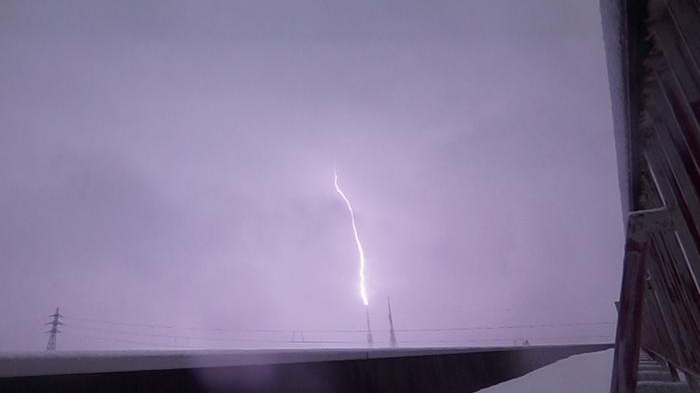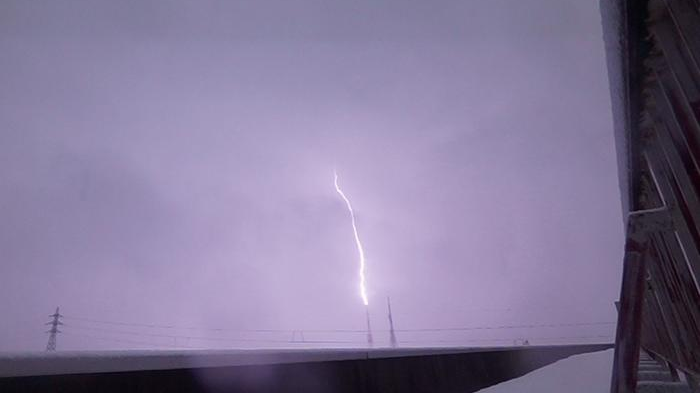
The most powerful explosions in the known universe come from what are known as gamma-ray bursts — though they may not sound particularly exciting, scientists usually speak about these incredible blasts of electromagnetic radiation in the same breath as giant collapsing stars and black holes.
We’ve catalogued quite a few of these events since the 1960s, and even used them to help us understand more about galaxy superclusters, but one particular kind of gamma-ray burst has remained somewhat of a mystery. It’s called a terrestrial gamma-ray flash (TGF), and it erupts inside thunderstorms on Earth hundreds of feet above our heads.
Yuuki Wada, a professor at Osaka University in Japan, has been studying TGFs for years. He’s the lead author on a new study that examines the mysterious relationship between TGFs and lightning bolts — and, according to this study, scientists have observed a TGF synchronized with a lightning discharge that arose from a collision of leaders, which guide lighting flow, coming from opposite directions.
“TGFs are one of the most energetic natural phenomena in the atmosphere,” Wada told Space.com. Wada’s work focuses on high-energy phenomena in lightning flashes and thunderclouds.
To gather data about lightning for study, the team traveled two hours north of Osaka to the seaside city of Kanazawa, located in Ishikawa Prefecture on the Northern coast of Honshu, Japan’s main island.
“We prepared an observation network around television transmission towers in Kanazawa,” Wada said. The researchers used a “state-of-the-art multi-sensor setup “that could detect optical, radio-frequency and high-energy radiation.
The multi-sensor observations they performed were a world first, senior author Harufumi Tsuchiya said in a statement, and that the combination of sensors helped them learn more about the mechanism for TGFs.
However, conducting the research for the study was challenging — and Wada said it required a bit of luck — as the study relied on being able to observe lightning bolts in action. “Lightning is hard to predict now,” Wada said. “So, there is a risk of performing intensive observations because detection ranges are limited.”
“There was a risk that we would detect nothing,” Wada added. “Fortunately, we detected a TGF with the full network.”
Gamma-ray flashes in thunderstorms
Scientists know thunderstorms emit very short TGFs, as well as longer gamma-ray flashes, which can last from minutes to hours. But thunderstorms still hold their share of mysteries.
The strong currents of air in thunderstorms can cause air and water to shoot up and down very quickly. When this happens, crystals of ice begin to collide inside the air currents, causing them to shed electrons and generate a lightning-producing electric field.
While scientists think that, under specific conditions, TGFs arise from discharges of lightning during thunderstorms, they still don’t understand the exact relationship between the two.
“TGFs have been mostly detected by satellites, and a detail of how lightning produces gamma rays remains a mystery,” Wada said. “Our ground-based observation gives us a clue to understand TGFs.”
Using the sensors on the transmission towers, the researchers caught a snapshot of lightning discharges along two paths. One path came from the thundercloud and led down to a transmission town. The other path ascended in the opposite direction.
The researchers observed the TGF right before the two discharge paths converged and created a highly concentrated electric field that the researchers say accelerated the electrons shooting through the air to near light speed.
One second contains one million microseconds. The team recorded the first photon of the TGF just 31 microseconds before the paths met. The full burst lasted 20 microseconds after the paths formed a lightning strike.
Related Stories:
This new study follows previous work delving into TGFs from a number of scientific organizations, including NASA and European Space Agency (ESA). In August 2023, NASA pilots flew into thunderstorms aboard a high-altitude science aircraft to gather data on TGFs.
In May 2019, ESA created the first-ever photo of a TGF, which arose from a thunderstorm over the island of Borneo, in Southeast Asia. To study the TGFs, they used a special observatory aboard the International Space Station.
The work to understand TGFs is far from finished. “The relation between lightning and TGF is not clear,” Wada says. “That is why we are continuing this study.”
“We are targeting winter thunderstorms in Japan,” he added. “Because they have unusual features compared to other thunderstorms, such as lower cloud bases, we expect more mysteries will be resolved by observations in Japan.”
The study was published on May 21 in the journal Science Advances.



